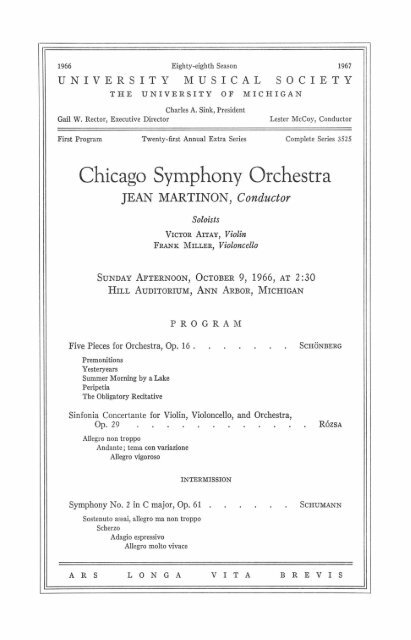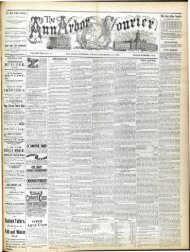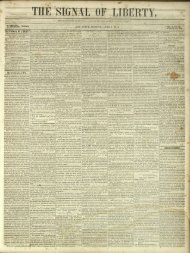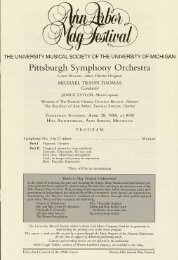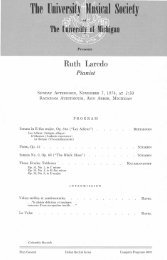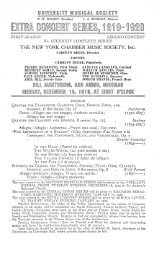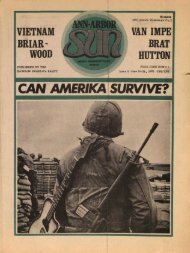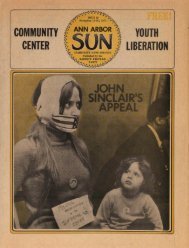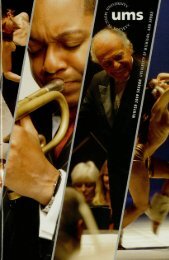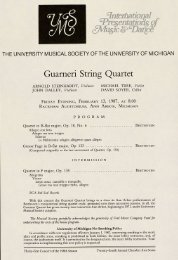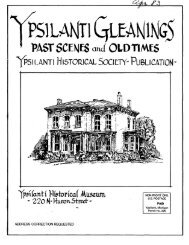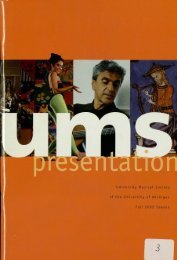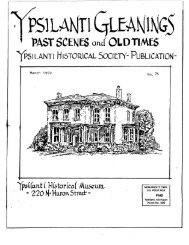Chicago Symphony Orchestra JEAN MARTINON, Conductor
Chicago Symphony Orchestra JEAN MARTINON, Conductor
Chicago Symphony Orchestra JEAN MARTINON, Conductor
You also want an ePaper? Increase the reach of your titles
YUMPU automatically turns print PDFs into web optimized ePapers that Google loves.
1966 Eighty-eighth Season 1967<br />
UNIVERSITY MUSICAL SOCIETY<br />
THE UNIVERSITY OF MICHIGAN<br />
Charles A. Sink, President<br />
Gail W. Rector, Executive Director<br />
First Program Twenty-first Annual Extra Series<br />
Lester McCoy, <strong>Conductor</strong><br />
Complete Series 3525<br />
<strong>Chicago</strong> <strong>Symphony</strong> <strong>Orchestra</strong><br />
<strong>JEAN</strong> <strong>MARTINON</strong>, <strong>Conductor</strong><br />
Soloists<br />
VICTOR AlTAY, Violin<br />
FRANK MILLER, Violoncello<br />
SUNDAY AFTERNOON, OCTOBER 9, 1966, AT 2 :30<br />
HILL AUDITORIUM, ANN ARBOR, MICHIGAN<br />
Five Pieces for <strong>Orchestra</strong>, Op. 16 .<br />
Premonitions<br />
Yesteryears<br />
Summer Morning by a Lake<br />
Peripetia<br />
The Obligatory Recitative<br />
PROGRAM<br />
Sinfonia Concertante for Violin, Violoncello, and <strong>Orchestra</strong>,<br />
Op. 29<br />
Allegro non troppo<br />
Andante; tema con variazione<br />
Allegro vigoroso<br />
<strong>Symphony</strong> No.2 in C major, Op. 61<br />
Sostenuto assai, allegro rna non troppo<br />
Scherzo<br />
Adagio espressivo<br />
Allegro molto vivace<br />
INTERMISSION<br />
SCHONBERG<br />
ROZSA<br />
SCHUMANN<br />
A R S LON G A V I T A BREVIS
PROGRAM NOTES<br />
By ARRAND P ARSDNS<br />
Five Pieces for <strong>Orchestra</strong>, Op. 16 . ARNOLD SCHONBERG<br />
Schonberg composed the Five Pieces for <strong>Orchestra</strong> in 1909 for a very large<br />
orchestra. In 1949 he prepared a new version of the work for an orchestra of reduced<br />
size, "to normal symphony orchestra proportions in order to facilitate performances,"<br />
according to the editorial note in the score.<br />
The Five Pieces fo r Orches tra were written some years before Schon berg evolved<br />
his system of composing known as the twelve-tone technique. However, by the year<br />
1909, the works of Schonberg are characterized hy several new qualities. First, there<br />
had been the "emancipation of the dissonance" as Schonberg described it in his essay<br />
in Style and Idea. Then, there is that aspect of his work which has been popularly<br />
called "atonal"; this term was not accepted by Schonberg, however. One of the chief<br />
spokesmen for Schonberg, Rene Leibowitz, has called it "the suspension of the tonal<br />
system" in his book, Schonberg and His School. After explaining the freedoms that<br />
adhere with the suspension of the "classic functions of tonality," Leibowitz continues:<br />
"Indeed, the free disposition of all the materials offered by the chromatic scale<br />
permits the invention jar its own sake of every imaginable melodic or harmonic<br />
form, as well as the unfolding of a purely contrapuntal style. In the same way, the<br />
typically Schonbergian compositional technique of perpetual variation can now be<br />
realized in a more consequent way, since musical structure will no longer be fettered<br />
by the requirements of symmetri cal reprises and specific tonal regions, and may, in<br />
extreme cases (as in certain works of Schonberg and especially of Webern), entirely do<br />
away with the idea of recapitulation."<br />
One fmal characteristic of this work is inherent in the shortness of the individual<br />
pieces. Prior to the development of the twelve-tone system with which Schonberg<br />
learned to extend the musical matter, he composed little pieces of great concision;<br />
otherwise he frequently wrote vocal music and relied on a text to help supply the<br />
formal aspects 0 [ the score. Closely related to the shortness of these pieces is the<br />
exploitation of tone color, or timbre, as a constructive element in music. The result<br />
of this practice produces most unusual sonorities.<br />
The score of Five Pieces fo r <strong>Orchestra</strong> originally contained only the tempo markings<br />
for each of the sections. Soon after the first performance of the work, however,<br />
Schonberg supplied titles to each of th e pieces. These titles, which appear in the 1946<br />
version of the score, are given as follows:<br />
1. Sehr rasch (Very quick) , Vorge fiihle (Premonitions), 2-8 time.<br />
2. Miissige Vie,'tel (A moderately moving quarter note), Vergangen es (Yester<br />
years), the meter is often changing.<br />
3. Miissige Viertel (A moderately moving quarter note) , S01llmer1ll0rgen an einem<br />
See (Summer Morning by a Lake), 4-4 time.<br />
4. Sell1' rasch (Very quick), Peripetie (P eripetia) , the meter changes.<br />
5. Bewegte Achtel (A moving eighth note) , Das obligate Reziiativ (The Obligatory<br />
Recitative), 3-8 time.
Sinfonia Concertante for Violin, Violoncello,<br />
and <strong>Orchestra</strong>, Op. 29 MIKLOS R6zSA<br />
The score of the Sinfonia Concertante for violin and violoncello was begun in<br />
Rapallo, Italy, in 1958 and was completed in Hollywood in 1963. In the three movements,<br />
the two solo instruments are treated primarily as a unit-they are combined in<br />
various ways, both harmonically and contrapuntally, and are contrasted with the<br />
sonorous so und of the orchestra. The two solo instruments are given imitative, or<br />
canonic, passages. The orchestra serves as an accompanying group, as the constrasting<br />
body of sound, and at times it becomes an equal partner in working out the musical<br />
material. The orchestra calls for pairs of woodwinds, four horns, three trumpets and<br />
trombones, timpani and a battery of percussion, and a quintet of strings.<br />
The first movement, allegro non troppo, is based on the sonata plan with two<br />
contrasting themes, a development of the themes, an extensive cadenza for the solo<br />
instruments, and a return in which the second theme comes first. The second movement,<br />
andante, consists of a theme, started fi rst by the cello, and a se ries of seven variations.<br />
Canonic writing is utilized in the first three variations j antiphonal treatment dominates<br />
the fourth and fifth j sustained motion characterizes the sixth j the violin restates the<br />
theme in the seventh, and a coda completes the movement.<br />
The fourth movement, allegro vigol'oso, follows the sonata idea again, and an<br />
extensive orchestra passage opens the work with first theme ideas. The second theme<br />
is slower and is heard first in the cello, and is then imitated by the violin. In the<br />
recapitulation, the second theme returns first. Brilliance characterizes the ending of<br />
the movement.<br />
<strong>Symphony</strong> No.2 in C major, Op. 61 ROBERT SCHUMANN<br />
The first sketches for the Second <strong>Symphony</strong> were made in 1845. The symptoms<br />
of Schumann's declining mental condition, present since 1843, had reached a crisis near<br />
the end of 1844. Schumann moved with his family to Dresden hoping the change might<br />
help. Improvement was slow. In a letter to Dr. G. D. Otten, founder and conductor of<br />
the Hamburg Musical Society, Schumann wrote: "I might indeed say it was the<br />
resistance of the spirit that was here at work and helped me to combat my condition.<br />
The first movement is full of struggle and in its character it is capricious and refractory."<br />
Even as late as April 1849 Schumann recalled, again to Dr. Otten, the terrible<br />
encounter with mental ill ness : "I wrote my symphony in December 1845 and I sometimes<br />
fear my semi-invalid state can be divined from the music. I began to feel more<br />
myself when I wrote the last movement, and was certainly much better when I finished<br />
the whole work. All the same, it reminds me of dark days. Your interest in a work<br />
so stamped with melancholy proves your real sympathy."<br />
Schumann shows both classical and romantic traits in this symphony. He bases<br />
his formal designs on classical patterns, yet he is not constrained to a literal application<br />
of these forms. His harmony, melody, and the general expressive character are definitely<br />
of his time. And his use of a motto theme as a means of giving unity to the movements<br />
of a large-scale work is, again , a characteristic of his own time. The motto theme<br />
begins the introduction to the first movement and reappears in the first and last movements.<br />
I t is possible that the motto theme has programmatic meaning and represents<br />
the "resistance of the spirit" to which Schumann referred in his letter to Otten. Likewise,<br />
the moving line of melody given to the strings which accompany the fi rst statement<br />
of the motto theme in the introduction might well refer to the "dark days"<br />
of 1844-45.


